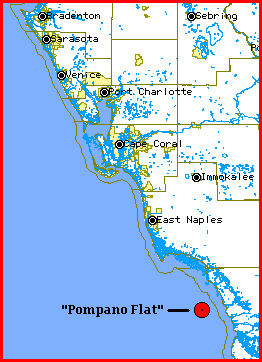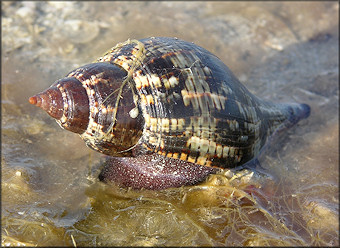
The southwest coast of Florida has always been the most popular
part of the state for shelling. From Anclote Key near Tarpon Springs,
southward to Cape Romano near Marco, wide areas of sandy shoreline
are exposed during low tides, particularly in the winter. Busycon
and Triplofusus, two of nature’s larger snails, dot
the sandbars and bay margins. Strombus, Dinocardium,
Neverita, Oliva and Fasciolaria can be found
popping out of exposed sand. Smaller forms leave their distinctive
trails in the sand, or cling to any available hard substrate.
For me, nowhere beats the Cape Romano
area. I first started visiting the islands and flats south of
Marco by canoe over twenty years ago. I was struck by the relatively
colorful and uneroded specimens I found. The Busycon perversum
(Linnaeus, 1758) [Lightning Whelk] were spinier than any I’d
seen to the north, and exhibited a wide range of pastel shades.
Conus anabathrum Crosse, 1865 [Florida Cone] and
Naticarius canrena (Linnaeus, 1758) [Colorful Moonsnail],
uncommon farther north, were found in good numbers inside the
barrier islands. Everything I’d found in the Tampa Bay area
was here, and more. Abundance, diversity, size and overall quality
were the best I’d seen.
I’ll divide the shelling in the
vicinity of Cape Romano into three types, and give examples of
each. These categories may be applied to any part of southwest
Florida.
- The Outside Flats -
These flats, when tides are very low,
appear as exposed areas of sand, shell and grass. They are transition
zones between inside, or bay environments, and the open Gulf.
Equivalents to the north would include the mouths of passes where
a similarly rich mix of Gulf and bay fauna is found.
 Just east of Cape Romano Island, two
areas, "Pompano Flat" [25.52N 081.38W], also known as "Pompano
Hump," and flats at the northeast side of "The Hump"
[25.51N 081.40W], with acres of very productive shelling at winter
lows, are always worth the visit. Just east of Cape Romano Island, two
areas, "Pompano Flat" [25.52N 081.38W], also known as "Pompano
Hump," and flats at the northeast side of "The Hump"
[25.51N 081.40W], with acres of very productive shelling at winter
lows, are always worth the visit.
The past two winters, Phyllonotus
pomum (Gmelin, 1791) [Apple Murex] and C. dilectus
(A. Adams, 1855) [Lace Murex] were abundant at both spots. Very
large Calliostoma tampaense (Conrad, 1846) [Tampa Bay Topsnail]
were found at Pompano. Busycon perversum, including several
albinos and a beautiful abnormally dextral specimen, were also
found at Pompano. Several albino Triplofusus were collected
at these spots as well.
An interesting discovery for me was that
Calotrophon ostrearum (Conrad, 1846) [Muave-mouth Drill]
are very commonly found with the Busycon egg cases that
are ubiquitous here.
Hespererato maugeriae (J. E. Gray,
1832) [Green Erato] and several columbellid forms were among the
species netted from the surrounding grass beds.
- The Gulf Beaches -
Sandy beaches and bars on the Gulf are
also worth visiting. These barrier islands include Keewaydin Island,
just northwest of Marco, Tigertail Beach at Marco, and the islands
to the southeast of Marco, Kice and Cape Romano Islands. The most
productive areas are near the ends of the islands where the broadest
bars develop near the passes.
Strombus alatus
Gmelin, 1791 [Florida Fighting Conch] and Busycon are common.
Smaller forms include Epitonium and Olivella species.
Several live Ficus papyratia (Say,
1822) [Atlantic
Figsnail] were found, with their siphonal canals poking from the
sand like the similar
Fulguropsis spirata
(Lamarck, 1816) [Pear Whelk]. Red forms of Fasciolaria tulipa (Linnaeus,
1758) [True Tulip] were found popping out of the sand at Tigertail
this last winter. Remember, a few days of westerly winds (which
often precede the lowest of wind-driven tides) can bring even
more exotic species ashore, dead and alive.
Several years ago, I found all the barrier
islands littered with colorful Argopecten gibbus (Linnaeus,
1758) [Atlantic Calico Scallop], still snapping their valves (and
fingers of collectors). Reasonably fresh Scaphella junonia
(Lamarck, 1804) [Junonia] have also been washed ashore here. My
favorite recent find was live Arcinella cornuta Conrad,
1866 [Florida Spiny Jewelbox], with very elegant and Spondylus-like
spines, blown ashore at Cape Romano.
- Inside Waters -
Protected by the barrier islands, Marco
area bays are well known to collectors as the place for Naticarius
canrena and Conus anabathrum, along with
the usual bay habitat sand-dwellers.
Triplofusus giganteus (Kiener,
1840) [Horse Conch], Busycon sinistrum and
Fulguropsis spirata
(Lamarck, 1816), Cinctura hunteria (G. Perry, 1811)
[Eastern Banded Tulip] and F. tulipa, Neverita delessertiana
(Récluz in Chenu, 1843), Dinocardium robustum
(Lightfoot, 1786) [Atlantic Giant Cockle], Trachycardium egmontianum (Shuttleworth,
1856) [Florida Pricklycockle] and D. muricata
(Linnaeus, 1758) [Yellow Pricklycockle] are among the common larger
shells here. A variety of lucinids, terebrids, tellinids, muricids
et. al. will be found here too. Netting sand
and grasses, and closely examining dead shells encountered will
substantially increase the number of species found.
Typically productive locations include
the bars and island margins on the Marco River and inside Caxambas
Pass. The terrain is often muddy and soft, so wear well-tied or
zippered shoes.
On the inside edge of Kice Island, I
found a peat bed near low-water. I was able to extract the pholads
Barnea truncata (Say, 1822) [Atlantic Mud-piddock] and
Cyrtopleura costata (Linnaeus, 1758) [Anglewing], and the
look-alike Petricola pholadiformis (Lamarck, 1818) [False
Anglewing]. Several Martesia species, also pholads, were
found in waterlogged wood nearby.
- Getting There -
While a visit to Tigertail Beach does
not require a boat, it is not legal to collect live shells there,
or anywhere on Marco. Rangers will likely check your bucket. Tip:
don’t bring one. Most other areas are reached only by boat.
Pontoon boats or airboats may be chartered at Marco or nearby
Goodland. Most captains now frown on live shelling so be upfront
with them about your intentions.
- Be Good -
The collectors who return from the trips
with buckets full of whelks and tulips contribute mightily to
the increasingly hostile environment we collectors find ourselves
in. Please – be selective and discreet. Do it for the environment,
and for the rest of us who want to pursue a legal and respected
hobby.
|